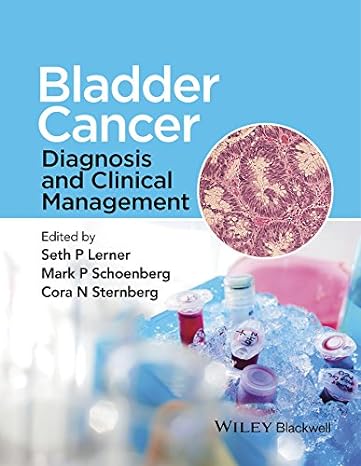Part I: Diagnosis and treatment of non‐muscle‐invasive bladder cancer
1 Pathology, 3
2 Risk stratification of high‐grade Ta, CIS, and T1 urothelial carcinoma of the bladder, 18
3 Utility of urine biomarkers, 26
4 Novel endoscopic techniques for the detection of bladder cancer, 39
5 Transurethral resection of bladder tumors, 51
6 Intravesical chemotherapy, 64
7 Intravesical immunotherapy, 76
8 HGT1 bladder cancer: Diagnosis and treatment, 89
9 What to do when bacillus Calmette‐Guerin fails, 98
Part II: T2–4
10 Selection and perioperative management of patients undergoing radical cystectomy and urinary
reconstruction, 111
11 Radical cystectomy: Techniques and outcomes, 127
12 Cystectomy in the female patient, 144
13 Laparoscopic/robotic radical cystectomy and urinary diversion: Outcomes, 156
14 Robotic assisted radical cystectomy and urinary diversion: Clinical trials, 167
15 Role of extended lymphadenectomy, 176
16 Management of the urethra in the cystectomy patient, 184
17 The role of radical cystectomy in patients with unresectable or regionally metastatic urothelial
carcinoma of the bladder, 190
Part III: Primary bladder‐sparing therapy
18 Radical transurethral resection, 201
19 Partial cystectomy, 212
20 Integrating chemotherapy and radiotherapy for bladder cancer, 221
Part IV: Urinary tract reconstruction
21 Orthotopic neobladder, 235
22 Continent cutaneous diversion, 244
23 Non‐continent urinary diversion, 258
Part V: Treatment of regionally advanced and metastatic bladder cancer
24 Molecular determinants of chemotherapy response, 273
25 Neoadjuvant chemotherapy in the treatment of muscle‐invasive bladder cancer, 284
26 Adjuvant chemotherapy for invasive bladder cancer, 295
27 Treatment of metastatic bladder cancer, 304
28 Treatment of poor risk patients, 320
Part VI: Genomics and the current status of urothelial cancer
29 Molecular events in muscle‐invasive bladder cancer development, 329
30 Cancer stem cells and intrinsic subtypes in bladder cancer, 342
31 Multi‐targeted agents in the treatment of urothelial carcinoma, 353
Part VII: Optimizing healthcare delivery
32 Patient navigation and cancer navigator programs, 365
33 Impact of health services on compliance and outcomes, 375
34 Quality of life and survivorship, 384
35 Bladder cancer: Healthcare delivery and third party payers, 395
36 Bladder cancer patient advocacy: Creating partnerships to advance patient care, research, and clinical
trials, 402
Bladder Cancer: Diagnosis and Clinical Management is a 100% clinically-focused guide to bladder cancer,
providing practical, modern and evidence-based guidance to the latest in diagnosis and management of the
condition. It differs from other books in its complete clinical focus as opposed to a heavy analysis of
pathogenesis or basic science. As a result, practicing urologists and oncologists in the clinical setting
will find it an essential resource to consult.
In addition to the latest in diagnostic tools and imaging methods, core focus is on the management of each
form of cancer at its various stages with up to date genomic data and targeted therapies. Both drug
therapies and the range of surgical options are covered, ensuring that this is the perfect tool for
clinicians to consult when considering which type of management program is appropriate for each individual
patient. A key addition is the final section dedicated to optimizing health care delivery, featuring
chapters on highly topical issues such as quality of life, patient advocacy and surgical education.
Full color throughout, and packed with excellent images, each chapter contains concise and didactic
practical tips and tricks to enrich the reading experience, in addition to management algorithms and the
very latest guidelines from the ASCO, AUA, ESMO and EAU concerning clinical management of bladder cancer.


